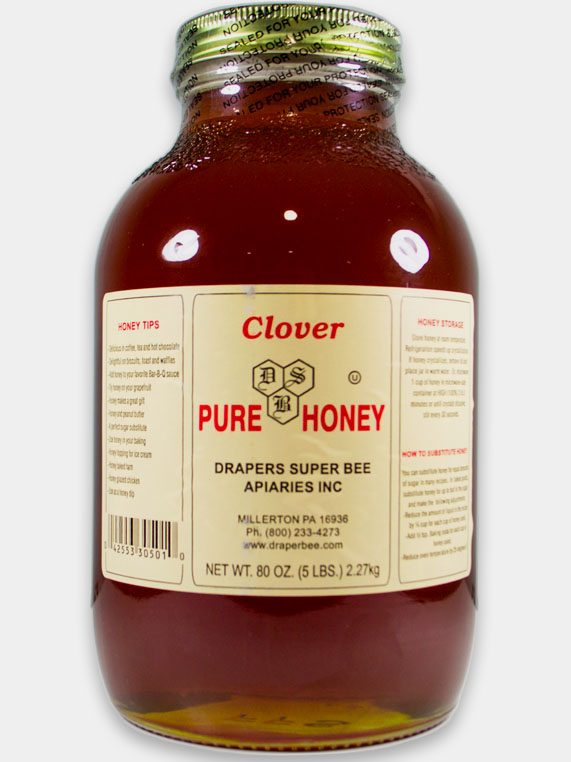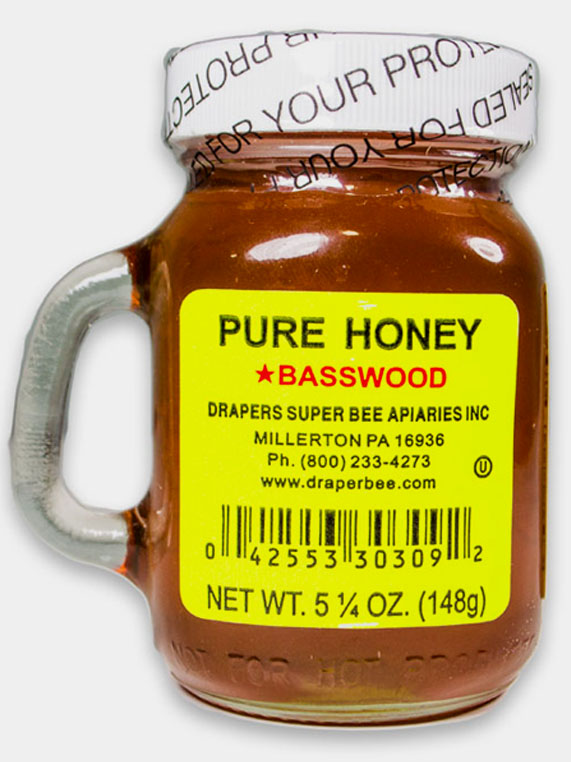Honey

About Honey
When bees have access to large areas of one kind of flower, such as clover, basswood, goldenrod, or buckwheat, they produce honey with a flavor and color typical of that particular plant.
Bees also make natural blends of honey from many different flowers in areas where no one flower predominates. Honeys are also blended during packing to produce a pleasing taste combination that can be duplicated throughout the year.
Honey flavors range from mild and bland to strong and pungent. The color ranges from black to white. Pigment (color) begins in the nectar at the plant and is transported back to the hive. It is intensified by the natural process that the bees put it through (reducing the moisture level, etc.). Darker colored honey does NOT mean lesser quality; it means a different source of nectar and a different taste of honey. By trying different honeys, you can find the ones you enjoy most.
Types of honey are: comb honey, liquid (extracted) honey, granulated (creamed) honey, and chunk honey.
is honey-filled beeswax comb as stored directly by the bees.
Liquid (extracted) honey is prepared by cutting off the wax cappings and whirling the comb in a honey extractor, where centrifugal force moves the honey out of the cells.
Granulated (creamy) honey is made by blending one part finely granulated honey with nine parts liquid honey. The mixture is stored at about 57 degrees until it becomes firm.
Chunk honey is comb honey in a jar with liquid honey poured around it.
If you wish to reliquefy naturally granulated honey, put the container in a double boiler or some other water bath at about 145 degrees. A microwave also works well. Loosen or remove the container lid and stir the honey once or twice while it is heating. As soon as the granules are dissolved, remove the honey from the heat and let it cool as quickly as possible. NOTE: Honey that is partially granulated is not going bad!
Both liquid honey and comb honey should be stored properly to maintain their quality. For home use, store in a dry location at 70 - 75 degrees. Make sure the cap is on tight because honey tends to absorb moisture, which can lower it's quality. For very long term, granulation free storage, keep sealed and in a freezer. Granulated or creamy honeys should kept at room temperature.
Probably the most asked question and one of the most difficult to answer is "what is raw & unprocessed, organic, unheated, or uncooked honey and is it best for me"? We, at Drapers, feel that these terms are used more to market the product than to benefit the consumer.
The facts are: 1. All honeys in containers are processed to some extent -- comb honey is the ONLY unprocessed honey.
2. LESS PROCESSED honeys (no heat applied) have more taste but can be susceptible to fermentation from sugar-tolerant yeasts which are always present in honey.
3. High temperatures used during processing (over 160 degrees) with filtration, tend to reduce granulation and help improve the looks of the products, however, natural enzymes are eliminated.
4. Straining or filtering IS NECESSARY (many different systems are in use) to present honey at it's best. Partially granulated honey on a shelf, sells very poorly.
5. Organic is a term that should not be used at all. Bees are nature's creatures and can not be controlled totally by beekeepers.
6. Just find a honey that looks and tastes good to you and enjoy!
Call Us Now
570-537-2381
Why Honey Instead of Sugar?
Honey has many unique flavors and is rich in history! It can be used in diverse ways from baked goods to a topping for cereal to a glaze for meat to a sweetener for tea. Honey is derived from the nectar of flowers and, unlike refined sugar, consists of various sugars which enter the blood stream at different times. It therefore has less effect on blood sugar levels than refined sugar.
When substituting honey for sugar in a recipe, begin by substituting honey for up to half of the sugar called for and reduce the amount of liquid in the recipe by 1/4 cup for each cup of honey added (note: because honey has more sweetening power than sugar, a reduced quantity of honey may be appropriate - adjust per your taste). Recipes containing honey need to be beaten longer and more vigorously than sugar recipes, and when baking with honey, add 1/2 teaspoon baking soda for each cup of honey used and lower the temperature by 25 degrees. Honey batter becomes crisp and browns faster than sugar batter. The floral source of the honey should be considered when cooking with honey since honey will impart some of it's flavor (darker, stronger honeys will allow more of a honey taste to come through in your finished product). Honey will provide a firmer, heavier texture.
Honey bees are vital to agriculture and the world's food supply. While gathering nectar to produce honey, bees are transferring pollen. The USDA estimates that one third of the food supply benefits from honeybee pollination.
Why Draper’s honey?
The answers to the above questions are often motivated by selfishness (the need to sell honey), by political correctness (or lack of it) depending on your opinion, and by the need to stimulate potential customers’ interest and knowledge.
Why U.S.A. produced honey?
U.S.A. honey is what you’re usually used to tasting (brings back fond childhood memories). U.S.A. honey production is subject to rules and regulations (inspections, sanitation, chemical use restrictions, etc.). U.S.A. honey is produced by your friends and neighbors. U.S.A. honey is one of the products of the bees who pollinate many crops that directly or indirectly supply all of us with a very large portion of our food! In summation U.S.A. honey provides wages for our families, food for our tables, and pollination for our crops.
Why Draper’s honey?
Obviously the selfish one - - we need your business. We are beekeepers who operate 1000 hives - - they produce a large portion of the honey we sell. Being producers ourselves, we take pride in selling only U.S.A. produced honey. What we can not produce ourselves, we buy from other, dependable U.S.A. based beekeepers. We have been here for almost 30 years, to be in business that long means you have to have satisfied customers, which we do! Why? Because we care about you and wish to keep you happy!
The higher rate?
This comes from many hidden things such as toll-free phone lines (we pay for them), Kosher certification (desirable but expensive), many sizes and styles of containers (costly inventory), many types of honey (very costly to maintain an inventory all year), retail facilities (U.P.S. shipping and walk in sales area), wholesale capabilities (delivery vans and support staff), computer systems to support both retail and wholesale operations, and many more little things that make a business convenient for you (not the least of which is a real person to answer the phone).
Final statement!
Our quality is our # 1 priority, we are dependable and we offer our customers a 100% money back guarantee. For wholesale accounts: you will get return sales (customer satisfaction), correct labeling (U.P.C., nutrition labeling, Kosher certification, and promotional materials - from the National Honey Board).



